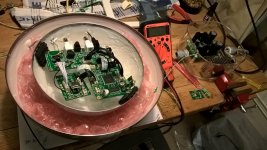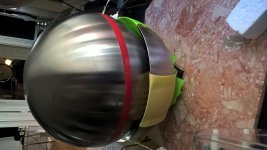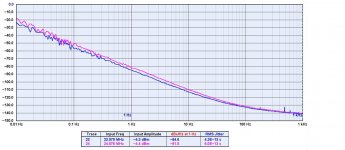I choose toslink because:
- No (or insignificant) level of bit error.
- Effective galvanic isolation
- toslink has high(er) jitter due to limited BW. DAM DAC has re-clocker so it should not matter. But I wish it was better.
//
- No (or insignificant) level of bit error.
- Effective galvanic isolation
- toslink has high(er) jitter due to limited BW. DAM DAC has re-clocker so it should not matter. But I wish it was better.
//
One of the very first things i tried with the DAM was feed it from Ian's FIFO on the assumption that an accurate clock signal will require less work from the pll. It certainly sounded different but i could not characterise it as being better. Needless to way i was surprised.
It is perhaps worth mentioning that my i2s signal is in any case low jitter, as it is sourced from a JLSounds XMOS with Crystek oscillators.
It is perhaps worth mentioning that my i2s signal is in any case low jitter, as it is sourced from a JLSounds XMOS with Crystek oscillators.
Last edited:
One of the very first things i tried with the DAM was feed it from Ian's FIFO on the assumption that an accurate clock signal will require less work from the pll. It certainly sounded different but i could not characterise it as being better. Needless to way i was surprised.
It is perhaps worth mentioning that my i2s signal is in any case low jitter, as it is sourced from a JLSounds XMOS with Crystek oscillators.
Doesn't JLS include some kind of reclocking on their boards anyway?
Yes, it does. Yet, in another dac i use a FIFO after the XMOS for effectively double reclocking and against all logic love the result 🙂
FIFO is not just a reclocker, the time shift effectively de-correlates all jitter.
FIFO is not just a reclocker, the time shift effectively de-correlates all jitter.
I don't dispute TNT's findings as in his case a high jitter signal gets reclocked prior to the DAM.
Yes, it does. Yet, in another dac i use a FIFO after the XMOS for effectively double reclocking and against all logic love the result 🙂
FIFO is not just a reclocker, the time shift effectively de-correlates all jitter.
Ok, thanks for clarifying.
And not only re-clocked - but buffered. I have at least 1 second delay. The clocked I used has a very low close-in noise so it is really stable - this should mean less need for adjustment in the DAM digital PLL and this less DAM clock adjustments.
The clock boards are built into a sealed sphere which in turn is put into a selad sphere which in turn is suspended like a turntable in half-a-sphere. All in 🙄
//
The clock boards are built into a sealed sphere which in turn is put into a selad sphere which in turn is suspended like a turntable in half-a-sphere. All in 🙄
//
Attachments
And not only re-clocked - but buffered. I have at least 1 second delay. The clocked I used has a very low close-in noise so it is really stable - this should mean less need for adjustment in the DAM digital PLL and this less DAM clock adjustments.
The clock boards are built into a sealed sphere which in turn is put into a selad sphere which in turn is suspended like a turntable in half-a-sphere. All in 🙄
//
😱


... The clocked I used has a very low close-in noise so it is really stable ....
//
Where have you found info on the close in noise of the NDK clocks? (You use the NDK NZ2520SDA?)
I got them from analog_sa - he had measured a lot of them. as it seems. 🙂
You just pay for every dBc at 1 Hz you want 😉
//
You just pay for every dBc at 1 Hz you want 😉
//
Attachments
Last edited:
Uh-oh. Now i am revealed as a clock pusher too 😀
The only way i could have measured those would be by comparing them to the stop clock on my Casio watch 😛
The only way i could have measured those would be by comparing them to the stop clock on my Casio watch 😛
IKEA forever 😉 The inside has a quite thick layer of the sh*t they make face masks with :-D
Sorry sa, maybe I made a p-po..?
//
Sorry sa, maybe I made a p-po..?
//
As you like to spend money for few dB ;-)
-118 dB at 10Hz you get her
http://www.wenzel.com/wp-content/parts/501-24224.pdf
You surely get a custom version at the right frequency.
-118 dB at 10Hz you get her
http://www.wenzel.com/wp-content/parts/501-24224.pdf
You surely get a custom version at the right frequency.
Thanks!! I have an unbuilt Andrea clock. As I recall it, it is even better. But I think I'm good as is 🙂
//
//
My future plan is, and I have all the gear for it, to build the Andrea clock, hook it up to 100m of professional opto link and burry it 75m away 1m down into the ground in my garden. Then I will just make an opto->electrical conversion without any oscillator and interface it to a clock-board that drives a DA. I would like this to be a DAM DAC but it might have to be something else I'm afraid.
Sören, make yet another mode which makes the DAC conversion rely totally on the clock without any adjustment - please?
You see, I don't fancy acoustical feedback via the clock.
//
Sören, make yet another mode which makes the DAC conversion rely totally on the clock without any adjustment - please?
You see, I don't fancy acoustical feedback via the clock.
//
Last edited:
I think at an certain point the quality of the signal feeding the DAM becomes pointless. The essential is the clock of the DAC itself and this one does not improve, even with an ideal input signal, over its own specs.
I know. Thats why I think the clock solution needs to be more flexible. I believe in the core signal processing and the ladder. If it doesn't happen I will have to switch platform. But I hope not... Note that the post above is purely about the clock and (hopefully) replacing the onboard one - i.e. different from my s/pdif jitter cleaner bowl. I think I can live with a little more random jitter if any music correlated is gone.
//
//
Last edited:
- Home
- Vendor's Bazaar
- Reference DAC Module - Discrete R-2R Sign Magnitude 24 bit 384 KHz


